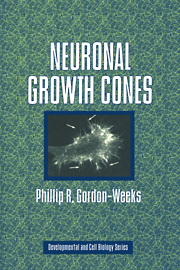3 - Pathfinding
Published online by Cambridge University Press: 29 August 2009
Summary
While studying the development of the retina and nervous system, we often asked ourselves this question: What are the mechanical causes of nerve fiber outgrowth and the sources of the marvellous power by which nerve expansions make direct contact with far-off neural, mesodermal, or epithelial cells?
Santiago Ramón y Cajal, Studies on Vertebrate Neurogenesis, 1960.Introduction
It has been realised for over a century that growth cones can navigate precise routes through the developing embryo to locate an appropriate cell with which to form a synapse (Ramón y Cajal, 1892). Growth cone navigation is generally known as ‘pathfinding’. Growth cone pathfinding has attracted considerable attention, both because of its importance in the formation of a properly connected, and therefore properly functioning, nervous system and because it is one of the most remarkable examples of cellular morphogenesis (for reviews see: Dodd & Jessell, 1988; Bixby & Harris, 1991; Hynes & Lander, 1992; Goodman & Shatz, 1993; Culotti, 1994; Tessier-Lavigne, 1994; Goodman, 1996; Goodman & Tessier-Lavigne, 1997). The distances over which growth cones must navigate in the embryo are usually relatively short, of the order of hundreds of micrometres (see ‘Demonstration of chemotropic factors in vitro’ below). Despite this, the navigational task facing growth cones is rarely simply a matter of following a straight path of least resistance; there may be many places along the route at which the growth cone must make large steering manoeuvres to locate the correct path.
- Type
- Chapter
- Information
- Neuronal Growth Cones , pp. 75 - 136Publisher: Cambridge University PressPrint publication year: 2000



